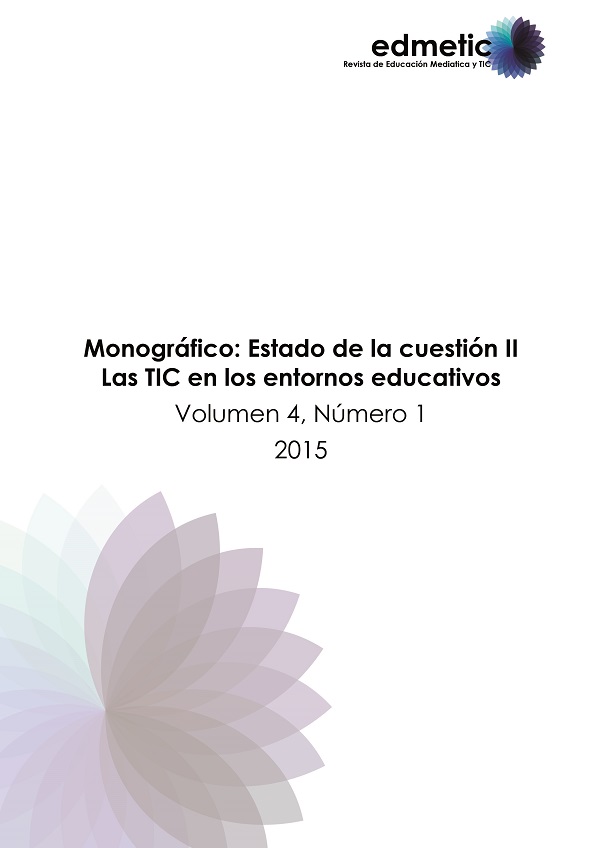Creatividad, mapas conceptuales y TIC en educación
Contenido principal del artículo
Resumen
Los mapas conceptuales, además de ser unas herramientas que nos permiten representar el conocimiento de manera gráfica y fomentar los aprendizajes, también pueden desarrollar la creatividad. En este trabajo mostramos diferentes relaciones existentes entre el proceso de construcción de mapas conceptuales y la creatividad humana. También se resalta la importancia del aprendizaje significativo y se profundiza en los diferentes principios que guían la creación de mapas conceptuales. Finalmente se presenta el software Cmaptools como una herramienta a tener en cuenta en los centros educativos ya que su utilización planificada puede tener resultados significativos en la mejora de los aprendizajes.
Descargas
Detalles del artículo
1. Política propuesta para revistas que ofrecen acceso abierto
Aquellos autores/as que tengan publicaciones con esta revista, aceptan los términos siguientes:- Los autores/as conservarán sus derechos de autor y garantizarán a la revista el derecho de primera publicación de su obra, el cuál estará simultáneamente sujeto a la Licencia de reconocimiento de Creative Commons que permite a terceros compartir la obra siempre que se indique su autor y su primera publicación esta revista.
- Los autores/as podrán adoptar otros acuerdos de licencia no exclusiva de distribución de la versión de la obra publicada (p. ej.: depositarla en un archivo telemático institucional o publicarla en un volumen monográfico) siempre que se indique la publicación inicial en esta revista.
- Se permite y recomienda a los autores/as difundir su obra a través de Internet (p. ej.: en archivos telemáticos institucionales o en su página web) antes y durante el proceso de envío, lo cual puede producir intercambios interesantes y aumentar las citas de la obra publicada. (Véase El efecto del acceso abierto).
2. Política propuesta para revistas que ofrecen acceso abierto diferido
Aquellos autores/as que tengan publicaciones con esta revista, aceptan los términos siguientes:- Los autores/as conservarán sus derechos de autor y garantizarán a la revista el derecho de primera publicación de su obra [ESPECIFICAR PERIODO DE TIEMPO], el cuál estará simultáneamente sujeto a la Licencia de reconocimiento de Creative Commons que permite a terceros compartir la obra siempre que se indique su autor y su primera publicación esta revista.
- Los autores/as podrán adoptar otros acuerdos de licencia no exclusiva de distribución de la versión de la obra publicada (p. ej.: depositarla en un archivo telemático institucional o publicarla en un volumen monográfico) siempre que se indique la publicación inicial en esta revista.
- Se permite y recomienda a los autores/as difundir su obra a través de Internet (p. ej.: en archivos telemáticos institucionales o en su página web) antes y durante el proceso de envío, lo cual puede producir intercambios interesantes y aumentar las citas de la obra publicada. (Véase El efecto del acceso abierto).
Citas
AUSUBEL, D. P. (1968). Educational Psychology: A Cognitive View. New York: Holt, Rinehart and Winston.
CABERO, J. (2007). Nuevas tecnologías aplicadas a la educación. Madrid: McGraw-Hill.
CARSON, D. K. y RUNCO, M.A.(1999). Creative Problem solving and problem finding in Young adults: Interconnctions with stress, Hassles and coping abilities. Journal of creative behavior, 33(3), 167-190.
CORBALÁN BERNÁ, J. (2008). ¿De qué se habla cuando hablamos de creatividad? CUADERNOS FHyCS-UNJu, 35,11-21.
GONZÁLEZ SANMAMED, M. (2007). Las TIC como factor de innovación y mejora de la calidad de la enseñanza. En J. Cabero (coord.). Tecnología educativa. Madrid: McGraw-Hill.
CORBALÁN, F.J., MARTÍNEZ, F., DONOLO, D., TEJERINA, M. y LIMIÑANA, R.M. (2003). CREA Inteligencia Creativa. Una medida cognitiva de la creatividad. Madrid: TEA Ediciones.
CSIKZENTMIHALYI, M.(1996). Creatividad. Madrid: Paidos.
GETZELS, J.W. y CSIKZENTMIHALYI, M. (1976). The creative vision: A longitudinal study of Problem finding in Art. New York: Wiley.
KANT, I. (1978). Crítica a la razón pura. Prólogo a la segunda edición. Madrid. Alfaguara.
LÓPEZ-GARCÍA, J. (2006). Del origen de los mapas conceptuales al desarrollo de CmapTools. Eduteka. Recuperado de: http://www.eduteka.org/Entrevista22.php (Consultado el: 03/07/2013).
LUBART, T. (2003). Psychologie de la créativité. Paris: Armand Colin.
HURLEY-HANSON, A. E. y Giannantonio, C. M. (Eds) (2013). Academic Reflections on the Life and Career of Steve Jobs. Journal of Business and Management, 19(1).
MARINA, J. A. (1993). Teoría de la inteligencia creadora. Barcelona: Anagrama.
NOVAK, J. D. y GOWIN, D. B. (1984). Learning How to Learn. New York, NY: Cambridge University Press.
NOVAK, J. D. (1998). Learning, Creating and Using Knowledge. Mahwah, New Jersey: Lawrence Erlbaum Associates, Publishers.
NOVAK, J. D. (2012). Novak, J.D. (2013). Empowering Learners and Educators. Journal for Educators, Teachers and Trainers, 4(1), 14 – 24.
NOVAK, J.D. y CAÑAS, A.J. (2004). Construyendo sobre Nuevas Ideas Constructivistas y la Herramienta CmapTools para Crear un Nuevo Modelo Educativo. Recuperado de: http://www.ihmc.us/users/acanas/Publications/NewModelEducation/NuevoModeloEducacion.pdf (Consultado el: 03/07/2013).
NOVAK, J.D. y CAÑAS, A.J. (2006) La Teoría Subyacente a los Mapas Conceptuales y a Cómo Construirlos. Technical Report IHMC CmapTools 2006-01, Florida Institute for Human and Machine Cognition (IHMC). Accesible en http://cmap.ihmc.us/Publications/ResearchPapers/TeoriaCmaps/TeoriaSubyacenteMapasConceptuales.html (Consultado el: 03/07/2013).
TORRANCE, E.P. (1967). The Minnesota studies of creative behaviour: National and International extensions. Journal of Creative Behaviour, 1, 137-154.
